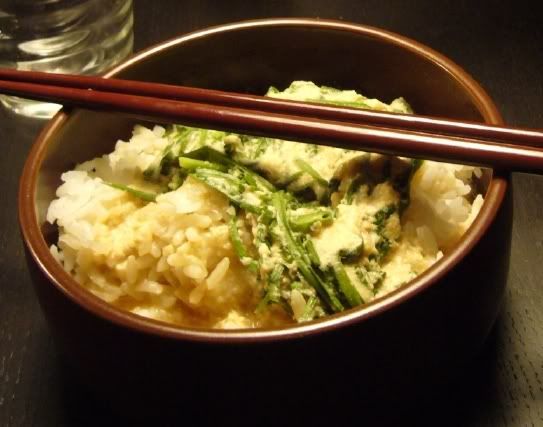Ponzu de replay: rice with nira & egg soup.
Sunday, 26 August 2007 by kinakoJam
The main theme for the August '07 issue of オレンジページ (Orange Page) magazine is 'summer drinking snacks fiesta'.
The recipe which we especially loved this month though, was on a page titled さらさらご飯 (Sarasara Gohan). Gohan means rice. Sarasara is an onomatope which can be used to describe the sound of a flowing brook, the feeling of smooth dry skin or the whisking of tea, amongst other things.
In this case it's being used to describe the special 'tsuyu' used in this summer recipe, a refreshing soup base made only from citrus & rice vinegar & soy a.k.a ponzu-shoyu (most common brand is 'Ajipon') and water.
Ajipon's web site claims Ajipon was developed in 1964, when the now ubiquitous ponzu was not so common. The Mitsukan president had some mizutaki in a restaurant and decided to mass-produce this fabulous dipping sauce. Three years of experimentation with different types of citrus and degrees of saltiness led to 'Ajipon', which includes mirin, katsuo-bushi, konbu (kelp), rice vingar, lemon, mandarin and valencia orange in its formula. Supposedly. Though the ingredients list on the label also includes corn syrup and glaringly omits the sweet mirin cooking sake, katsuo-bushi fish flakes and konbu.

Ponzu is commonly used as a refreshing dipping sauce (especially for nabe hotpot) or as a salad dressing ingredient...this is the first time I've seen it as a soup base. Orange Page also recommends, on really hot days, to pour the same water-ponzu mixture over rice, but to chill the soup first. Now that's sarasara.
Ponzu tsuyu soup base:
Combine 1/4 cup of Ajipon or other flavoured ponzu-shoyu with 1 cup water.
Recipe: rice with chicken-Nira-egg-soup
Adapted from Orange Page magazine.
Serves 2.
1 chicken breast (50 g) - or 1/4 sachet konbu kelp stock powder
Nira (garlic chives, 韭菜 or ku chai in chinese, could be substituted with bärlauch) 1/3 bunch (30 g)
2 eggs, lightly beaten
2 medium-sized bowls of warm rice (about 300 g, I think we used a little more though)
Ponzu tsuyu soup base
- If you are using chicken, cut it into 5 mm bite sized pieces; trim the nira and cut it into 2 cm lengths.
- In a small pan, heat the chicken or konbu powder and the ponzu tsuyu over medium heat. Skim off any foam and add the nira. When the ingredients seem cooked, add the beaten egg while stirring. When the egg-soup mixture has thickened somewhat, turn off the heat and pour an equal amount over each bowl of rice.
(We made this without the chicken, and instead added a 1/4 sachet of konbu stock powder to the broth. It was totally delicious. Savoury, a little piquant from the vinegar but not sour or sharp at all; warm, mellow and tasty from the Nira/garlic chives, which are available from all asian grocery stores: just look for the long-ish grassy chives-like ready cut bunches).

Note: the ideal time to eat this may be in summer, but let's face it, it's not much of a summer in Cologne at the moment. The deep savouriness of the dish does however lend itself to a warming meal when the skies look so grey and ambivalent - and of course, any soupy-kayu-type dish with rice has its comfort value.
The recipe which we especially loved this month though, was on a page titled さらさらご飯 (Sarasara Gohan). Gohan means rice. Sarasara is an onomatope which can be used to describe the sound of a flowing brook, the feeling of smooth dry skin or the whisking of tea, amongst other things.
In this case it's being used to describe the special 'tsuyu' used in this summer recipe, a refreshing soup base made only from citrus & rice vinegar & soy a.k.a ponzu-shoyu (most common brand is 'Ajipon') and water.
Ajipon's web site claims Ajipon was developed in 1964, when the now ubiquitous ponzu was not so common. The Mitsukan president had some mizutaki in a restaurant and decided to mass-produce this fabulous dipping sauce. Three years of experimentation with different types of citrus and degrees of saltiness led to 'Ajipon', which includes mirin, katsuo-bushi, konbu (kelp), rice vingar, lemon, mandarin and valencia orange in its formula. Supposedly. Though the ingredients list on the label also includes corn syrup and glaringly omits the sweet mirin cooking sake, katsuo-bushi fish flakes and konbu.

Ponzu is commonly used as a refreshing dipping sauce (especially for nabe hotpot) or as a salad dressing ingredient...this is the first time I've seen it as a soup base. Orange Page also recommends, on really hot days, to pour the same water-ponzu mixture over rice, but to chill the soup first. Now that's sarasara.
Ponzu tsuyu soup base:
Combine 1/4 cup of Ajipon or other flavoured ponzu-shoyu with 1 cup water.
Recipe: rice with chicken-Nira-egg-soup
Adapted from Orange Page magazine.
Serves 2.
1 chicken breast (50 g) - or 1/4 sachet konbu kelp stock powder
Nira (garlic chives, 韭菜 or ku chai in chinese, could be substituted with bärlauch) 1/3 bunch (30 g)
2 eggs, lightly beaten
2 medium-sized bowls of warm rice (about 300 g, I think we used a little more though)
Ponzu tsuyu soup base
- If you are using chicken, cut it into 5 mm bite sized pieces; trim the nira and cut it into 2 cm lengths.
- In a small pan, heat the chicken or konbu powder and the ponzu tsuyu over medium heat. Skim off any foam and add the nira. When the ingredients seem cooked, add the beaten egg while stirring. When the egg-soup mixture has thickened somewhat, turn off the heat and pour an equal amount over each bowl of rice.
(We made this without the chicken, and instead added a 1/4 sachet of konbu stock powder to the broth. It was totally delicious. Savoury, a little piquant from the vinegar but not sour or sharp at all; warm, mellow and tasty from the Nira/garlic chives, which are available from all asian grocery stores: just look for the long-ish grassy chives-like ready cut bunches).

Note: the ideal time to eat this may be in summer, but let's face it, it's not much of a summer in Cologne at the moment. The deep savouriness of the dish does however lend itself to a warming meal when the skies look so grey and ambivalent - and of course, any soupy-kayu-type dish with rice has its comfort value.
